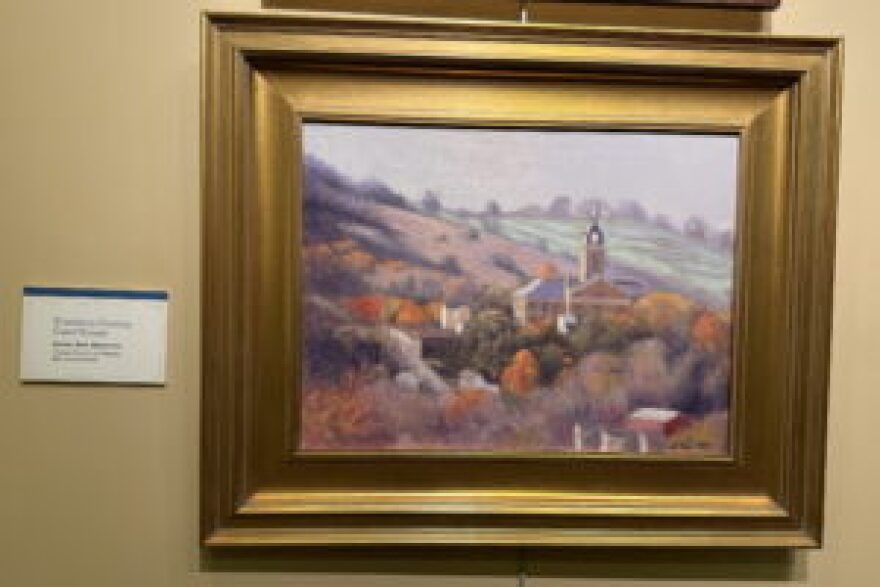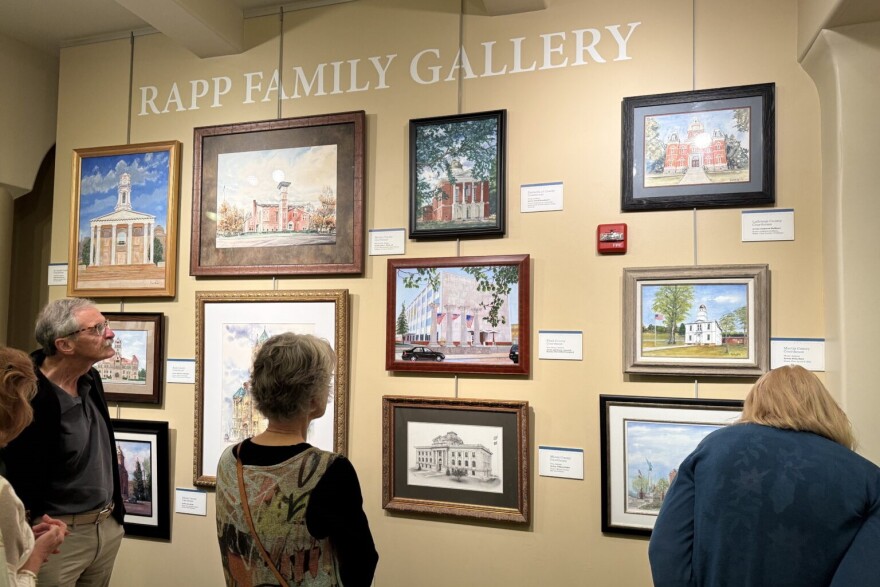The Randolph County Courthouse was once saved by seven elderly women wearing nothing but porcelain replicas of the building they were trying to protect. In Rome, Indiana — which long ago lost its status as Perry County’s seat — the original, early 19th-century courthouse still stands proudly near the Ohio River. And in Cass County, a local artist unknowingly contributed a decades-old painting to a now-complete, and eclectic, collection celebrating Indiana’s county courthouses.
They’re just a few of the stories brought to life in a new temporary exhibit highlighting the state’s historic county courthouses, which opened Friday at Indiana Landmarks’ Rapp Family Gallery in Indianapolis.

The exhibit features 92 original artworks — one from each of Indiana’s counties — and represents the culmination of an 18-year project led by Noblesville attorney Doug Church.
“The paintings are all sizes, they’re all different kinds of approaches to the art,” Church said during a talk at the gallery Friday evening. “There are oils, pastels, pen and ink, there’s a woodcut. It’s really remarkable. … It is eclectic to the max.”
The exhibit is the result of a long-running collaboration between Indiana Landmarks, the Indiana State Bar Association and the Indiana Bar Foundation, with contributions from judges, lawyers, historians, artists and community members across the state.
Since 2007, Church has worked to collect an original artwork for each of Indiana’s county courthouses — some current, some historic, and some “a little of both.”
Church praised the buildings themselves as “secular cathedrals” that symbolize the rule of law and anchor communities across the state.
With no artistic restrictions on medium or style, the collection now includes everything from juried contest winners to historic pieces long stored in basements or donated by local groups
“Doug’s courthouse project isn’t just about creating beautiful artwork, though the 92 pieces are truly stunning,” said Michael Jasaitis, president of the Indiana State Bar Association. “This project represents something far more profound. It’s about understanding that courthouses are the beating heart of our communities, the physical manifestation of our commitment to the rule of law.”
A statewide search
As Church recounted, the project began when he convinced his own Hamilton County Bar Association to commission a painting for his 2007 installation as president of the state bar. That painting, of the courthouse just across the street from his law office in downtown Noblesville, became the first in the collection.
Eighteen years and thousands of miles later, Church has amassed 91 handcrafted images — plus one woodcut — each representing a different courthouse. Nearly all are tied to a unique story, the lawyer said.
The painting of the Cass County Courthouse, for example, was completed by late artist Helen Irene Miller Murphy, who left behind hundreds of works now housed with the Logansport Art Association. Church had nearly given up on Cass County when the association reached out with an offer.

“They said, ‘We found a courthouse, and we’re willing to sell,’” he recalled. “Reluctantly, I responded. … I said, ‘I really appreciate that, but we want a loan.’ There was nothing for a while. And then I got a call, they said, ‘We’ve changed our minds. We’ll donate it.’”
The Cass County piece, obtained earlier this year, was the final one needed to complete the statewide collection.
The painting by Murphy, who passed away in 2015 at 103 years of age, is not dated but was likely completed in the late 1950s, Church said.
Another standout is the courthouse painting for Tippecanoe County, where the local bar association raised funds for a juried art contest and commissioned seven different artworks, including one of the county courthouse. The opening reception in Lafayette ultimately drew 40 submissions and hundreds of attendees.
Artwork depicting each of Indiana’s 92 county courthouses are now on display at the Indiana Landmarks Center in Indianapolis. (Casey Smith/Indiana Capital Chronicle)In Randolph County, residents famously rallied against plans to raze their courthouse in the early 2000s.
The resistance included “seven women ranging in age from 77 to 94,” recalled Clay Miller, former president of the Indiana State Bar Association and a past Indiana Landmarks board member.
“They were all part of the bridge club … wearing only their birthday suits, strategically concealed by porcelain models of the original witness,” Miller said during the Friday presentation.
Their protest, featured in the documentary “Courthouse Girls of Farmland,” helped save the structure that’s now topped once more with its iconic clock tower.
Symbols of law and community
But the courthouse buildings themselves are more than civic architecture, said historian Elizabeth Osborn.

“They are the brick and mortar representation or symbol of the civic ideals and aspirations of the people who commissioned them, paid for them, and saw them as important parts of their community,” said Osborn, director of education at Indiana University’s Center on Representative Government.
She described Indiana’s courthouses as “head and shoulders” above their neighbors — literally. Often the tallest and grandest buildings in their towns, they serve as physical symbols of justice, order and community pride.
Even today, Osborn noted, when courthouse interiors might be guarded by metal detectors, or even when courts move to other locations, the buildings still function as local hubs — housing not just courtrooms, but government offices, public records and community events.
“You paid your taxes there, you registered to vote, you maybe served on a jury,” she said. “Courthouses were the center of the community.”
“And now,” Osborn continued, “courthouses are being preserved, even after they fall out of use for their intended purposes.”
From basements to the gallery
Many of the pieces in the exhibit were collected or discovered via chance encounters, archival hunts or personal connections, Church said.
One painting, of the historic Madison County Courthouse, sat in storage at the Anderson Library for years before Church arranged its donation. His father had originally gifted the piece in honor of Church’s late mother, a trustee of the library.
Some courthouses were painted by professionals, others by hobbyists. Some depict newly built justice centers, like those in Marion or Floyd counties, while others capture long-lost historic courthouses — like Delaware County’s original building, replaced in the 1960s.

In Steuben County, Church accepted a courthouse painting by an unknown artist after a judge discovered it in the basement.
“The judge was so excited to give me this painting,” Church said. “Then he said, ‘Come on up,’ and took me to the top of the courthouse tower. It was one of those special moments.”
The exhibit will remain on view at Indiana Landmarks Center for the foreseeable future, though Church and the bar association hope it eventually finds a permanent public home.
The “ultimate objective” is for the artwork to be displayed “in a public place,” like a state judicial building … when the state of Indiana finally decides to build one.”
“Our fingers are crossed,” Church said. “We want them all to be displayed, where everyone can see them.”
The collection’s mission, he added, is not just about art, but about honoring the legacy and continued relevance of Indiana’s county courthouses.
“These are the biggest buildings. The most significant architecture,” Church said. “They’re secular cathedrals. And we’re lucky.”
Indiana Capital Chronicle is part of States Newsroom, a nonprofit news network supported by grants and a coalition of donors as a 501c(3) public charity. Indiana Capital Chronicle maintains editorial independence. Contact Editor Niki Kelly for questions: info@indianacapitalchronicle.com.




